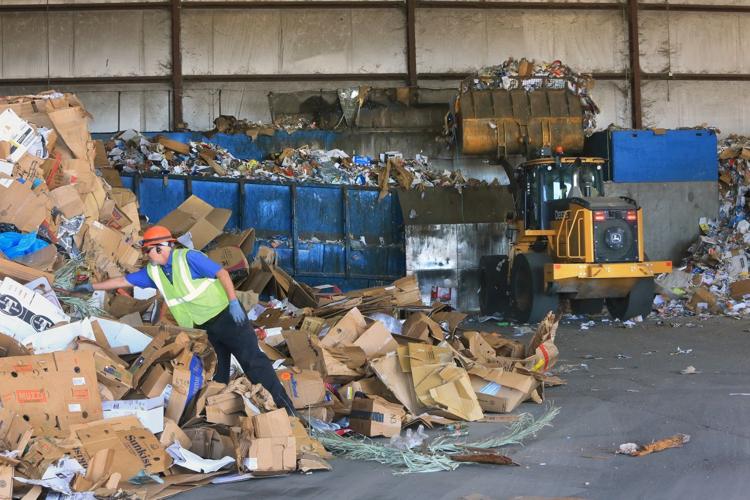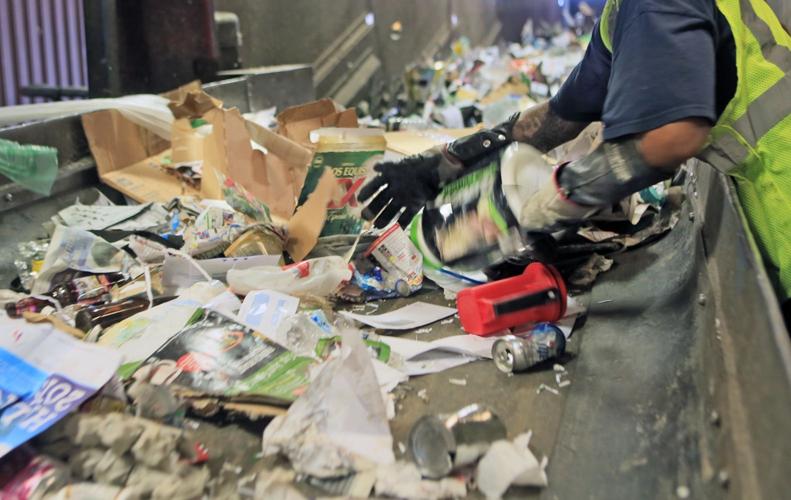Go blue or go green.
It’s a decision made thousands, maybe a million times every day when local residents try to figure out what to do with their trash — recycle or send it to the landfill.
Tucson is one of the best cities in the country when it comes to participation in recycling, said Sherri Ludlam, environmental specialist with the city of Tucson’s Environmental Services Department. Roughly 90 percent of city residents recycle at some level, and it’s a slightly higher number outside the city limits — 92 percent — where Waste Management, Inc., provides the service.
But there’s a trend that needs to get turned around, Ludlam said.
“We have a terrific participation rate,” she said. “But we’re running at about a 20 percent contamination rate. It’s much higher than we would like. It’s not terribly unusual for Arizona, but 15 percent is the industry standard.”
In other words, about 20 percent of what city residents currently throw in their blue recycling bins instead should be going in their green trash bins to start the trip to the landfill. When you get it wrong, it can literally clog up the elaborate system for sorting and packaging material for recycling. Sometimes it’s even dangerous for the employees whose job it is to manually separate materials at ReCommunity, Inc., the city’s recycling contractor since 2012.
On a given day, said local ReCommunity Manager Doug Jennings, the tons of material that arrives at the recycling center at East Ajo Way and South Alvernon Way can include lumber with nails in it, cactus, sharp metal objects, and one of the most dangerous items of all, used hypodermic needles — all of which should be disposed in other ways.
Jennings said he’s even seen a hot water heater and a toilet arrive in a load of what was supposed to be recyclable material. Last week he stood near a pile of material that included a tire rim and a used set of brakes from a car, a broken down folding chair, a couple of desktop computers, stereo equipment and a basketball, all of which made their way there because someone tried to recycle them in their blue bins.
Admittedly, the decision has become a little more involved as more and more products fall into the recyclable category, which Ludlam estimates is about 60 percent of an average household’s trash. Both the city of Tucson and Waste Management provide a detailed list of what can be recycled on their respective websites and in education materials they provide.
“It can fluctuate a little bit,” Ludlam said of the ratio of what is recyclable and what should go to the landfill. “I think as the marketplace of packaging has changed, people look at something and they think, ‘OK, can I or can’t I,’ and they’re standing there trying to decide. But they’re only going to do that for so long and then it’s either going to go in the trash or it will be something that we can’t accept (for recycling), and then we wind up with a high contamination rate.”
While the intentions, even in the case of a water heater, are generally good when a person recycles an item instead of sending it to the landfill, Jennings said, recycling the right items can enhance progress toward the ultimate goal — keeping items that can be used again out of the landfill.
Recycling items that shouldn’t be means that every three hours in a work day, the elaborate and highly technical recycling machinery has to be shut down so all the contaminants can be cleaned out from the various mechanisms.
“We process 200 tons of material a day in an eight- to nine-hour shift,” Jennings said. “Three times a day, we clean out the wrappage, the plastic bags, the garden hoses, the ropes, the chords, anything that can wrap up around a shaft.”
The biggest culprit is the plastic grocery bags that are common throughout the nation, but which have been the target of communities that are outlawing them. Those bags usually can be recycled by taking them back to the grocery stores. But they generally aren’t accepted in any recycling program anywhere in the country, said Isha Cogborn, senior communication specialist for Waste Management, Inc.
“From community to community, what we can recycle is slightly different,” Cogborn said. “Across the board nationally there are three rules that apply no matter what. You can recycle all empty water bottles and aluminum cans in every program. You need to keep food out of the material. And you have to keep plastic bags out of recycling bins.
“Nationwide, 69 percent of water bottles don’t make it into recycling bins and 49 percent of aluminum cans end up in garbage cans,” Cogborn said. “We need to make sure that none of these end up in garbage cans.”
Manual sorters at the recycling center have to have strong hand-and-eye coordination skills to try to grab each and every one of those bags and other non-recyclables as they speed by on conveyors at various sorting points in the process. But some are inevitably missed, Jennings said, and if enough of them get by, the machinery can automatically shut down.
When one of those big items comes by, like a tire rim, a sorter has to be quick on a pedal that shuts down the conveyor to pull it off safely, Jennings said.
The technology that does the lion’s share of the sorting has made it possible for the machinery at ReCommunity, Inc., to accept a wider variety of items than ever.
When the contract that was won by ReCommunity, Inc., in 2012 went out for bid, the Environmental Services Department included an increased number of items that it wanted included in the program and the successful bidder was going to have to build a system to meet the criteria, Ludlam said.
ReCommunity’s system can separate the types of material automatically. Gravity helps separate paper and cardboard from heavier items like glass, cans and plastics. Sensors at other points in the process separate aluminum from heavier metals and from plastic and glass. Even different types of plastic can be separated from each other automatically.
When it all gets spit out at the end, the materials are compressed and bundled to be sent to the various locations where they will be processed to be used again.
Jennings said 75 tons of paper and 50 tons of cardboard leave the recycling facility every work day. Everything is compacted and bundled into large bales that will fit in a semi-tractor trailer. Aluminum cans are compacted in 1,000-pound bales. Other metals, mostly cans, are bundled into 2,000-pound bales. Aside from the paper and cardboard, Jennings said, about 50 tons of material per month shipped out.
And rest assured, Ludlam said, if you put it in your recycling bin, it is recycled if it’s an accepted material. There a lot of excuses for why people don’t recycle including the myth that recycled materials go to the landfill, which Ludlam said is just that, a myth.
“There are people who just say I’m not going to sort my trash,” she said. “They’re just flat out not going to do it. Everybody in the country has had education programs, and I wouldn’t say that we’re asking for a lifestyle change. But we’re trying to change minds.”







